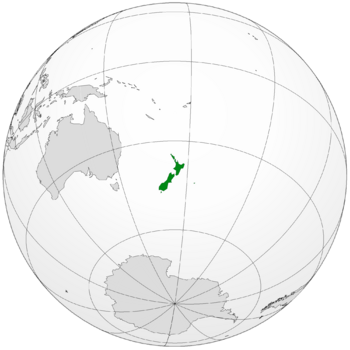Yangaea
The Community of Yangaea | |
|---|---|
|
Flag | |
| Motto: "The World's Nation." | |
 | |
| Capital | Xate |
| Largest | Yang |
| Official languages | English-Maori creole |
| Ethnic groups (1988) |
|
| Demonym(s) | Yangaean |
| Government | Oligarchy |
| Notable Historical Events | |
• Original British Settlement | 1840 |
• The Revelation | 1991 |
| Area | |
• Total | 268,021 km2 (103,483 sq mi) |
| Population | |
• Estimate | 3,550,000 (76th) |
| Currency | Yang (YNG) |
| Time zone | UTC +13 |
| Driving side | left |
| Calling code | +822 |
Yangaea, officially the 'The Community of Yangaea', is a small island country off of the coast of Perth. The nation identifies itself as a socialist anarchy, but generally operates as an oligarchy, with the power being shared by two elected leaders.
History
Ancient native history (pre-1840)
The islands were originally inhabited by a population called the Maori, who likely arrived from other nearby islands. The island was undiscovered by the developed world until its discovery by Brittanian explorers in the late 1600s. The native population at the time of discovery was around 250,000, almost all of which lived as a part of one tribe in southern Yangaea. The tribe depended on fishing and hunting the local iguanas for sustenance.
Colonization and Collapse (1840-1872)
After the British colonized Perth, they looked to also take what they called "New Perth", or modern day Yangaea. They sent in around 2,000 men in June of 1840 to build a city and "civilize" the natives. 6 months later, a British general came to check on the colony. The white men had completely accepted the native culture, and abandoned Christianity for the native folk religion. In addition, around 75% of the native women had been impregnated by the European settlers. Not long after the settlers and natives had completely assimilated into one single society. When a British ship returned in early 1872 to check in on the colony's progress, the ship was captured and converted into a European-themed amusement park.
The Silent Years (1872-1991)
Ignoring the occasional execution of foreign explorers, the new nation remained completely detached from the international world for over 100 years. During this time there were many important technological, cultural, and administrative breakthroughs. The North Island became the main source of food for the nation, as fertile soil and a huge coastline allowed for grain farming and fishing, respectively. This economic development reflected a reverse result in South Island, where the population became very centralized around factories and eventually cities. This urbanization resulted in a dramatic population increase, which is still seen today; North Island holds 20.2% of the entire population of the nation, while South Island has 74.0% (the rest live in minor outlying islands). The cultural disparity is what inspired the government structure seen today. One Chief is elected, via compulsory voting, to represent each island (see Politics and Government). Another notable development during this time was the rise of wind power, all starting when a farmer (called "Wind-Guy in local folklore) hooked his windmill, previously being used for smashing grain, up to magnets and wires. He created the first wind turbine, which he powered his lights and house with. The rest of the nation soon caught on, and nearly all of electrical energy comes from wind turbines.
Modern Era (1991-present)
In 1990, the election of Chieftess Scott in South Island brought immediate change. Not only was she the first elected female, but also the first chief to have ever visited a foreign country. She immediately proposed The Revelation, a plan to open up Yangaea to the rest of the world. This proposal included opening immigration, sharing of technology, as well as the construction of foreign embassies. This plan was approved by Chief Adams of North Island in 1991, and began the construction of the capital building in Xate.
Geography
Climate
Environment
Politics and government
Military
Foreign relations
Economy
Energy
Industry
Infrastructure
Transport
Demographics
Education
Religion
Culture
Music and art
Cuisine
Sports
This article is from APSIA 1.2. For the most recent iteration of APSIA, look at Category:APSIA 2.B |

